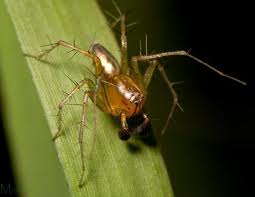Lynx Spider
Category: Arachnida Spider

Facts about Lynx Spiders, The members of the family Oxyopidea are commonly known as the Lynx Spiders. These species are considered to exhibit social behavior unlike any other spiders of the nature. The Lynx Spider are generally into pollinating from flowers and they do not prefer spending time at their webs building them rather they prefer hunting other spiders that crawls through the plants and leaves. The Lynx Spider vary in sizes and are mostly from tiny to medium size. They are absolutely green in color which makes them very hunting prone because it helps them hide beneath the grass and the leaves and makes them stay unnoticed.
These types of spiders are mainly found in the United States of America and are very common in North America. The Lynx Spider hardly bite humans and are very much into attacking other insects and animals. The Lynx Spider are very much useful when it comes to controlling pests and insects from affecting farms and places. It is considered that a large amount of pesticides cannot bring about the change that could be brought about by some Lynx spider. The Lynx Spider are amazing when it comes to getting steer clear of their prey and are very much particular about it.
The muscles in a Lynx Spiders legs pull them inward, but the spider can't extend its legs outward. It will pump a watery liquid into its legs that pushes them out. A Lynx Spider’s legs and body are covered with lots of hair and these hairs are water-repellent, which trap a thin layer of air around the body so the Lynx Spiders body doesn't get wet. It allows them to float, this is how some spiders can survive under water for hours. A Lynx Spider feels its prey with chemo sensitive hairs on its legs and than feels if the prey is edible. The leg hair picks up smells and vibrations from the air. There are at minimum, two small claws that are at the end of the legs. Each Lynx Spiders leg has six joints, giving the spider 48 leg joints. The Lynx Spider’s body has oil on it, so the spider doesn't stick to it’s own web.
Lynx spiders vary in length but the female spiders are about 18 to 20 mm in length and the male spiders are about 10 to 12 mm which makes the female spiders longer and stronger compared to the male spiders. The Lynx Spider have red patches throughout the backside of them and also towards the corner of their eyes otherwise these spiders are absolutely green in color which happens to be a very favorable option for them. Their legs are pale green colored and have black dots all over them. The habitat and lifestyle of the Lynx Spiders have been a topic of research and study for a long time now and still continues to be so.
Spiders belong to a group of animals called "arachnids", mites and Scorpions and a tick is also in the arachnid family. An Arachnids is a creature with eight legs, two body parts, no antennae or wings and are not able to chew on food. Spiders are not insects because insects have three main body parts and six legs and most insects have wings.
The Arachnids are even in a larger group of animals called "arthropods" an invertebrate animal of the large phylum Arthropoda, which also include spiders, crustaceans and insects. They are the largest group in the animal world, about 80% of all animals come from this group. There are over a million different species. There are more than 40,000 different types of spiders in the world.
Lynx Spiders have oversize brains.
In the Lynx Spider the oxygen is bound to "hemocyanin" a copper-based protein that turns their blood blue, a molecule that contains copper rather than iron. Iron-based hemoglobin in red blood cells turns the blood red
Lynx Spiders have two body parts, the front part of the body is called the Cephalothorax-(the thorax and fused head of spiders). Also on this part of the body is the Lynx Spider’s gland that makes the poison and the stomach, fangs, mouth, legs, eyes and brain. Lynx Spiders also have these tiny little leg-type things called (pedipalps) that are next to the fangs. They are used to hold food while the Lynx Spider bites it. The next part of the Lynx Spiders body is the abdomen and the abdomens back end is where there is the spinnerets and where the silk producing glands are located.
A Lynx Spiders stomach can only take liquids, so a spider needs to liquefy their food before they eat. They bite on their prey and empty its stomach liquids into the pray which turns it into a soup for them to drink.
A male Lynx Spider has two appendages called "pedipalps" a sensory organ, instead of a penis, which is filled with sperm and insert by the male into the female Lynx Spider’s reproductive opening.
Spiders do not have a skeletons. They have a hard outer shell called an exoskeleton-(a rigid external covering for the body in some invertebrate animals). The exoskeleton is hard, so it can’t grow with the spider. The young Lynx Spiders need to shed their exoskeleton. The Lynx Spider has to climb out of the old shell through the cephalothorax. Once out, they must spread themselves out before the new exoskeleton will harden. Know they have some room to grow. They stop growing once they fill this shell. Female Lynx Spiders are usually bigger than males.
Female spiders lay eggs on a bed of silk, which she creates right after mating. Once the female Lynx Spider lays her eggs, she will than cover them with more silk.

 Back To Category Arachnida Spider
Back To Category Arachnida Spider